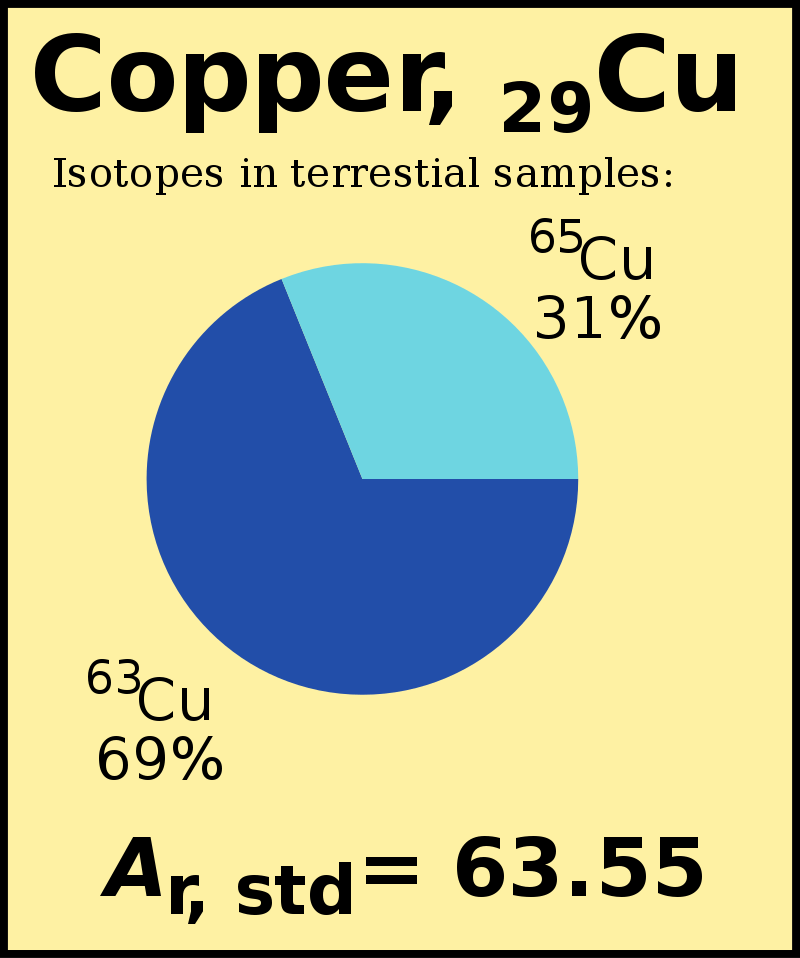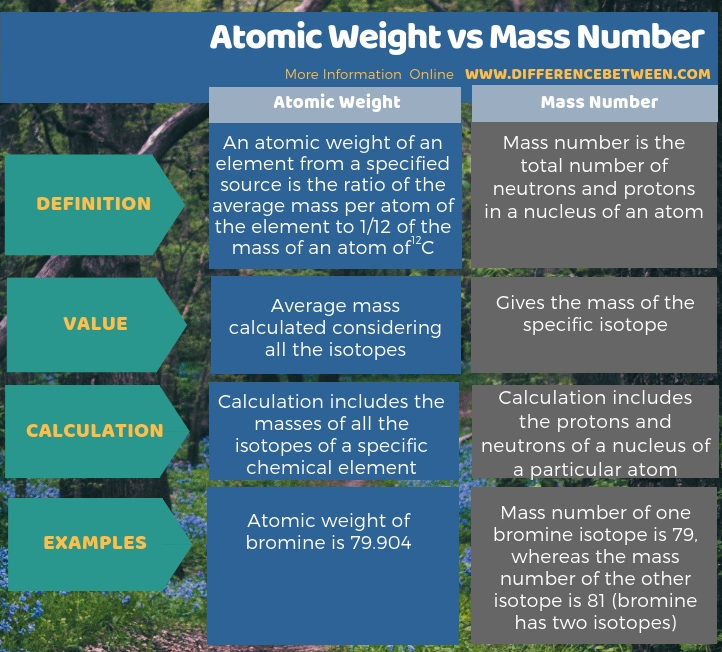Difference Between Atomic Weight and Mass Number
Table of Contents
The key difference between atomic weight and mass number is that atomic weight is the average mass calculated considering all the isotopes whereas mass number is the mass of a specific isotope.
We can characterize atoms by their atomic numbers and mass numbers. In the periodic table, atoms are arranged according to their atomic number. Mass number of an element is related to its mass. However, it does not give the exact mass of the atom. Atomic weight is another way of expressing the weight of atoms, but this is different from the atomic mass. However, it is important to identify the meaning of these terminologies separately, because they can make large differences in measurements if we use them interchangeably.
CONTENTS
1. Overview and Key Difference
2. What is Atomic Weight
3. What is Mass Number
4. Side by Side Comparison – Atomic Weight vs Mass Number in Tabular Form
5. Summary
What is Atomic Weight?
Atoms mainly contain protons, neutrons, and electrons. Atomic mass is simply the mass of an atom. Most of the atoms in the periodic table have two or more isotopes. Isotopes differ from each other by having a different number of neutrons even though they have the same amount of protons and electrons. Since their neutron amount is different, each isotope has a different atomic mass. Atomic weight is the average weight we calculate considering all the masses of isotopes. Each isotope is present in the environment, in different percentages. When calculating the atomic weight, we need to consider both isotope mass and their relative abundances.

Figure 01: Standard Atomic Weight of Copper
Moreover, the masses of atoms are extremely small, so we cannot express them in normal mass units like grams or kilograms. The weights given in the periodic table are calculated as above and are given as relative atomic mass.
However, the IUPAC definition for atomic weight is as follows:
“An atomic weight (relative atomic mass) of an element from a specified source is the ratio of the average mass per atom of the element to 1/12 of the mass of an atom of 12C.”
The mass of the most abundant isotope contributes more towards the atomic weight. For example, the natural abundance of Cl-35 is 75.76%, while the abundance of Cl-37 is 24.24%. The atomic weight of Chlorine is 35.453 (amu), which is closer to the mass of the Cl-35 isotope.
What is Mass Number?
Mass number is the total number of neutrons and protons in the nucleus of an atom. We usually call the collection of neutrons and protons as nucleons. Therefore, we can define the mass number also as the number of nucleons in the nucleus of an atom.
Normally, we denote this value in the left upper corner of the element (as superscript) as an integer value. Different isotopes have different mass numbers because their neutrons vary. Thus, the mass number of an element gives the mass of the element in integers. The difference between mass number and atomic number of an element gives the number of its neutrons.
What is the Difference Between Atomic Weight and Mass Number?
The key difference between atomic weight and mass number is that atomic weight is the average mass calculated considering all the isotopes whereas mass number gives the mass of the specific isotope. Most of the time, the mass number is considerably different from the atomic weight. For example, bromine has two isotopes. The mass number of one isotope is 79, whereas the mass number of the other isotope is 81. Moreover, the atomic weight of bromine is 79.904, which is different from both the isotope masses.

Summary – Atomic Weight vs Mass Number
Atomic weight and mass number are two different concepts in chemistry. The key difference between atomic weight and mass number is that atomic weight is the average mass calculated considering all the isotopes whereas mass number gives the mass of the specific isotope.
Reference:
1. Helmenstine, Anne Marie. “Atomic Mass Definition: Atomic Weight.” ThoughtCo, Jan. 22, 2019, Available here.
Image Courtesy:
1. “CIAAW 2013 – Standard atomic weight for cupper (29, Cu)” By DePiep – Own work (CC BY-SA 4.0) via Commons Wikimedia
ncG1vNJzZmivp6x7pbXFn5yrnZ6YsqOx07CcnqZemLyue8OinZ%2Bdopq7pLGMm5ytr5Wau26t06ikoptdrLKqs8etZJqmlGLDtHnMmqqsZZ6quqOx0Wg%3D